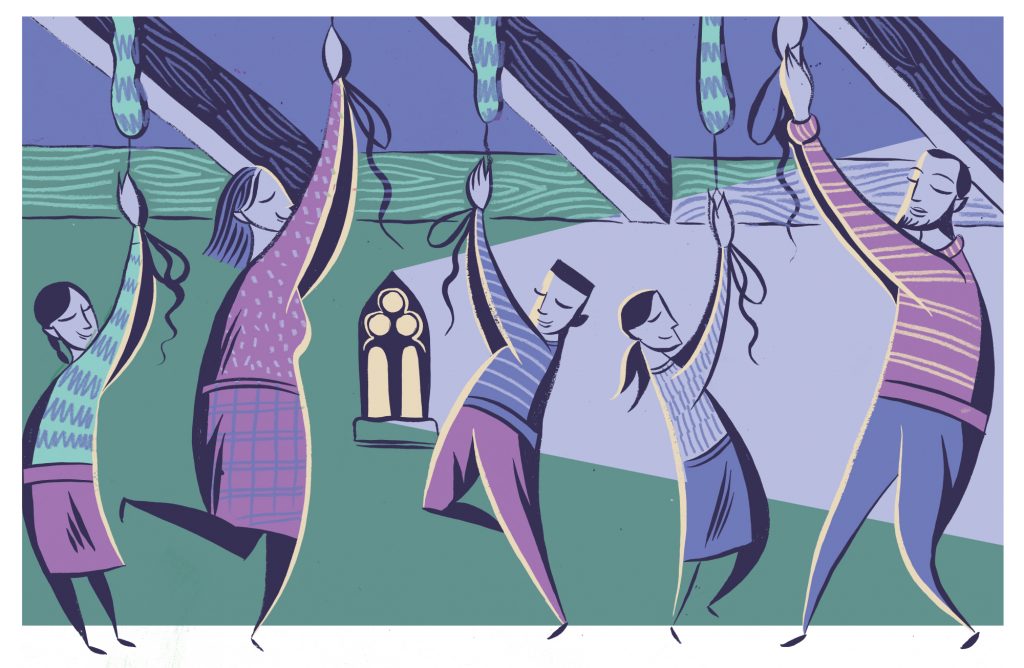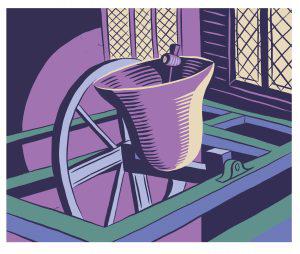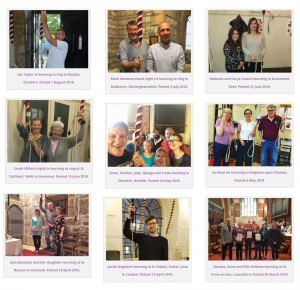This project is now closed
Ringing Remembers
 1,400 bell ringers hailing from across the UK died during the First World War. Ringing Remembers sought to recruit 1,400 new bell ringers in their memory.
1,400 bell ringers hailing from across the UK died during the First World War. Ringing Remembers sought to recruit 1,400 new bell ringers in their memory.
When the bells rang out on 11 November 1918 they announced the end of the most catastrophic war the world had yet seen. All new ringers rang together across the country on 11 November 2018 as part of the national commemorations to mark the centenary of the Armistice.
New recruits total
2,792 ringers were recruited to be part of this unique nationwide project – very nearly double the target! Existing ringers, the public and the media got behind the campaign, greatly contributing to its enormous success.
Many new ringing bands were started in towers where ringing had not happened for years or even decades. Many further bands were strengthened in numbers.
These ringers and communities now have lifelong memories tied into the centenary of the First World War. Through their learning they honoured the memory of the 1,400 bell ringers and helped the UK mark the centenary in an unforgettable way.
Ringing on Armistice day
Ringing Remembers was funded by the Ministry for Housing, Communities and Local Government. You can read more about the UK Government’s national WW1 commemoration activities, in which bell ringing played a leading role, on the Armistice 100 website. You can also see where bell ringing took place on The Ringing World’s Armistice 100 BellBoard event.
Learning to ring
Read more about what bell ringing involves and discover how Ringing Remembers recruits were getting on with their learning during the campaign.
New learners will always be welcome to join towers up and down the country to learn a new skill that is both a sport and an art, a mental exercise and good for focus and fitness. You can become part of a friendly and sociable community, both locally and nationally, and connect with an ancient British tradition. Ringing is open to adults and children alike, with the youngest learners normally around the age of 10. Read more on the Central Council of Church Bell Ringers website.
The-cut off date for registering as a Ringing Remembers campaign recruit was 11 November 2018. No further registrations are being accepted.
Bell ringers lost their lives
 Many bell ringers joined the war effort, and many lost their lives. Just after the war, the Central Council of Church Bell Ringers (CCCBR) wrote to all bell towers to compile the Roll of Honour. At the time a thousand men were reported as lost. During the First World War Centenary the CCCBR has been reviewing this list and has discovered a further 400 bell ringers who died in service. Two bell towers—Edington in Wiltshire and Bamburgh in Northumberland —lost 6 ringers each during the war. In total 1,400 bell ringers lost their lives. A loss to them and their families. A loss to communities.
Many bell ringers joined the war effort, and many lost their lives. Just after the war, the Central Council of Church Bell Ringers (CCCBR) wrote to all bell towers to compile the Roll of Honour. At the time a thousand men were reported as lost. During the First World War Centenary the CCCBR has been reviewing this list and has discovered a further 400 bell ringers who died in service. Two bell towers—Edington in Wiltshire and Bamburgh in Northumberland —lost 6 ringers each during the war. In total 1,400 bell ringers lost their lives. A loss to them and their families. A loss to communities.
Bells rang out for the Armistice
When the bells rang out on 11 November 1918 they announced the end of the most catastrophic war the world had yet seen. At that time, bells were at the heart of the community, marking events of great significance and as a means of communication long before modern technology connected us. At the end of the war, many people heard about the Armistice through bell ringing.

Bell ringing in Britain
Bell ringing is a British tradition, and the British Isles are home to a distinctive style of bell ringing called ‘change ringing’ which produces a peal of bells, part of our national ‘soundscape’. Most people don’t realise that outside the British Isles change ringing towers are few and far between. While the British Isles has some 5,500 change ringing towers, the rest of the world put together has less than 150.
Bell ringing is woven into the fabric of our society, marking rites of passage in our lives including christenings, weddings and funerals. It often marks and forms part of important local occasions and national celebrations – recently this has included the Queen’s Diamond Jubilee, the London Olympics and Paralympics and the Lumiere light festival in Durham. Bell ringers have regular competitions, and often come together to ring just for the joy of it.
Although bell towers are commonly in churches, you don’t have to go to church to be a bell ringer. Bell ringers are a friendly, inclusive community with people of all faiths and none. With 5,500 bell towers in Britain, there’s at least one near you!
Ringing Remembers leaflets and posters
Download the Ringing Remembers poster, leaflet and illustrations.
Share your Ringing Remembers stories
Share your stories with us on social media using #RingingRemembers and join the Ringing Remembers Facebook group.
![]() @Big_Ideas_Co
@Big_Ideas_Co ![]() Big Ideas
Big Ideas ![]() _bigideas
_bigideas
Email us at bells@big-ideas.org.
Sign up to the Big Ideas newsletter on our subscribe page to receive Ringing Remembers and other WW1 centenary activity updates from across the country.



Ringing Remembers is funded by the Ministry of Housing, Communities and Local Government, and is a partnership with the Central Council of Church Bell Ringers. Ringing Remembers is part of Remember Together, which brings diverse communities together to commemorate shared – and often sidelined – heritage, bringing significant marginalised heritage into the mainstream.

